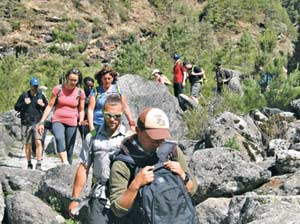

79pc of arrivals in 2012 were first-time visitors

Around 79 percent of the arrivals in 2012 were making their first visit to Nepal. According to the Tourism Ministry, there were 803,092 visitors to Nepal last year, among whom 632,767 were first timers.
The male-female ratio making their maiden trip to Nepal is almost equal. There were 331,731 males and 301,036 females.
Travel trade entrepreneurs said that first-time visitors were good for the tourism industry as they participate in more activities and explore more destinations. However, they said that the industry should not neglect repeat visitors who, despite spending less money, project a positive indication of tourist satisfaction.
Traders added that the industry should strive to achieve a balance between first-time and repeat visitors which is important for the sustainability of Nepal’s tourism.
“Due to diverse tourism products, Nepal has a good history of encouraging first-time visitors to plan their next trip to Nepal,” said Aditya Baral, spokesperson of the Nepal Tourism Board. “However, the number of repeat visitors is nominal.”
Baral said that Nepal’s diverse tourism products were one of the main reasons encouraging visitors to make a second trip. For instance, tourists who visit the Everest region on their first trip may go to other completely different destinations the second time around.
There are more than 20 percent repeat visitors annually. “If the country succeeds in attracting more than 30 percent repeat visitors, it would be good promotional medium for Nepal’s tourism industry.”
Repeat visitors are loyal visitors who stay longer but spend less than first timers since they are destination-aware tourists. Travel trade entrepreneurs said that repeat visitors perceive the overall value for money. “Besides, they are a promotional medium who recommend Nepal to friends and relatives, resulting in a positive word-of-mouth effect,” said Baral.
Meanwhile, Ganga Sagar Pant, chief executive officer of the Trekking Agencies’ Association of Nepal, believes that political instability and safety issues have discouraged visitors from returning to Nepal. “As a result, the number of repeat visitors is gradually declining, and this scenario has worried travel trade entrepreneurs.”
However, due to the cost factor, Nepal has not lost repeat visitors in significant numbers. “The industry needs to satisfy new visitors by offering new products and packages so that they keep coming back,” Panta said. An increasing trend of first-time visitors is always a worrying factor, and there is a need to balance the number of first-time and repeat visitors for the sustainability of the country’s travel industry, he added.
According to him, an increase in Chinese and Indian arrivals who love exploring new destinations is also a reason why there are more first-time visitors to Nepal. Since 2010, Nepal has been witnessing an increase in tourist flow from both the neighbouring countries.
Last year, tourist arrivals hit an all-time high, although the average length of stay was shorter. The average length of stay of tourists in Nepal slipped to 12.87 days in 2012 from 13.12 days in 2011. According to the ministry, 48 percent of the total arrivals visited Nepal for travel and holidaymaking.
Around 14 percent of the tourists went trekking and mountaineering, the segments that require tourists to spend long periods outside Kathmandu. Similarly, over 13 percent of the tourists in Nepal last year came for pilgrimage, according to the ministry.
Nepal recorded the highest length of stay of tourists in 1996 which reached 13.50 days. The shortest stay of 7.92 days was recorded in 2002. The contribution of tourism to the country’s GDP increased to 2.0 percent in 2011-12 from 1.8 percent in 2010-11. In 2009-10, tourism contributed 2.4 percent.
The country earned Rs 30.70 billion from the travel sector in 2011-12 against Rs 24.61 billion in 2010-11.
source: the kathmandu post, 8 June 2013








